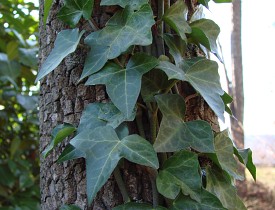Five Invasive Plants Not to Plant in Your Garden
 If you have ever seen a weed take over your whole garden or yard, you've witnessed invasive plants in action. The following invasive species look like common garden plants. However, they are capable of quickly multiplying and crowding out native plants in open spaces, like woodlands and wetlands.
If you have ever seen a weed take over your whole garden or yard, you've witnessed invasive plants in action. The following invasive species look like common garden plants. However, they are capable of quickly multiplying and crowding out native plants in open spaces, like woodlands and wetlands.
English Ivy: This ground cover is popular in North America, but unfortunately it escapes from gardens easily. It is known to crowd out forest floors by preventing other plants from receiving enough sunlight. If you are set on using English Ivy as a groundcover, be aware that it must be trimmed back often in order for it not to spread. If you are willing to prune your English Ivy regularly, it poses a minimal risk of spreading. A native alternative to English Ivy is Allegheny Spurge (Pachysandra procumbens). Allegheny Spurge is a sturdy groundcover with green foliage.
Purple Loostrife: Purple Loosestrife is a perennial herb that is native to central and southern Europe and parts of Asia. It is characterized by a square, woody stem and magenta blooms. Purple Loostrife takes over wetland areas, where it outcompetes with native plant species which provide better nutrition to wildlife. Regulations in Minnesota, Illinois, and Wisconsin prohibit buying and selling Purple Loostrife. Several insect species have been approved by the US Department of Agriculture for controlling it on a large scale. Although it was introduced in the 1800s as an ornamental plant, it’s a good choice for gardens today. Native alternatives to Purple Loostrife are Purple Aster, New England Aster, and Bee Balm.
Yellowflag Iris: The Yellowflag Iris is easy to mistake for native irises. It is a wetland plant that colonizes into monotypic stands, crowding out native wetland plants. Yellowflag Iris spreads easily from gardens to neighboring lands. Although it colonizes in wetlands, Yellowflag Iris is very drought-resistant. It grows in both saltwater and freshwater wetlands. If you are planting irises, be sure that you are planting native iris cultivars, as Yellowflag Iris is highly invasive.
Yellow Toadflax: Also known as “wild snapdragon,” Yellow Toadflax looks a lot like native snapdragons. They grow horizontal, interconnected root systems, and therefore grow in clusters. Yellow Toadflax thrives in moist to well-drained soil. Though Yellow Toadflax was introduced to America as an ornamental plant, it is considered to be an invasive weed. Plant native Snapdragons, rather than Yellow Toadflax.
Bush Honeysuckles: Unlike the sweet smelling vine honeysuckles that are ever so delicious, bush honeysuckles are invasive plants native to Asia. They are deciduous bushes that are able to thrive in many environments, from wetlands to woodlands. The woody bushes grow in thickets, and can easily dominate the habitat where they grow. If you are introducing honeysuckle to your garden, be sure that you are planting native honeysuckle vines, rather than honeysuckle bushes.
For help removing any of these invasive species or choosing native plants for your garden, consult a knowledgeable landscaping professional.
Updated September 13, 2018.
Looking for a Pro? Call us (866) 441-6648

Landscaping Average Costs
Landscapers Experiences

Lawn Repair: Contractor Followup To My DIY Prep Got The Job Done

Yard Cleanup And Lawn Care Service With A Great Work Ethic



